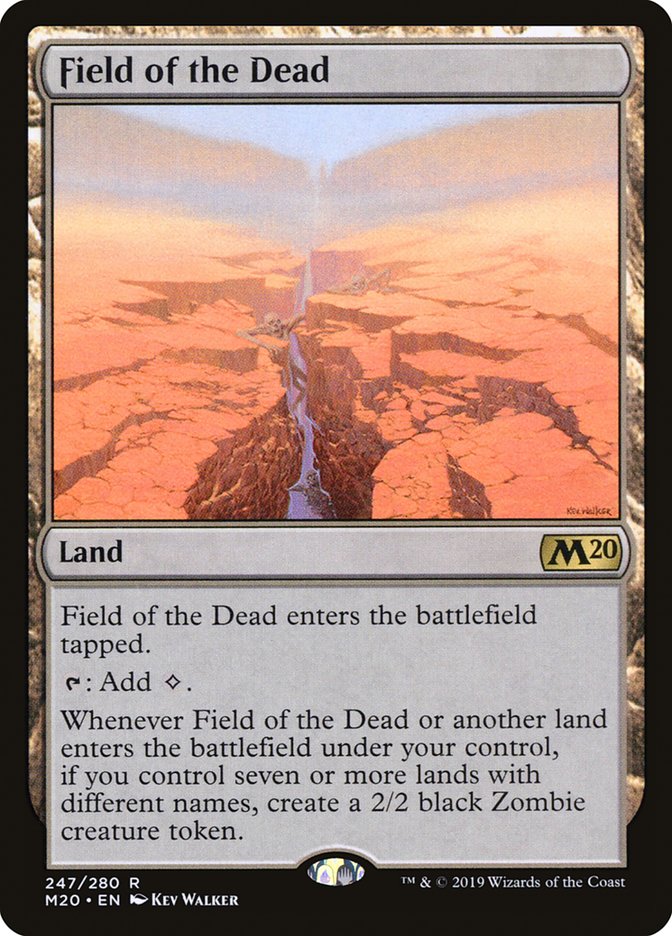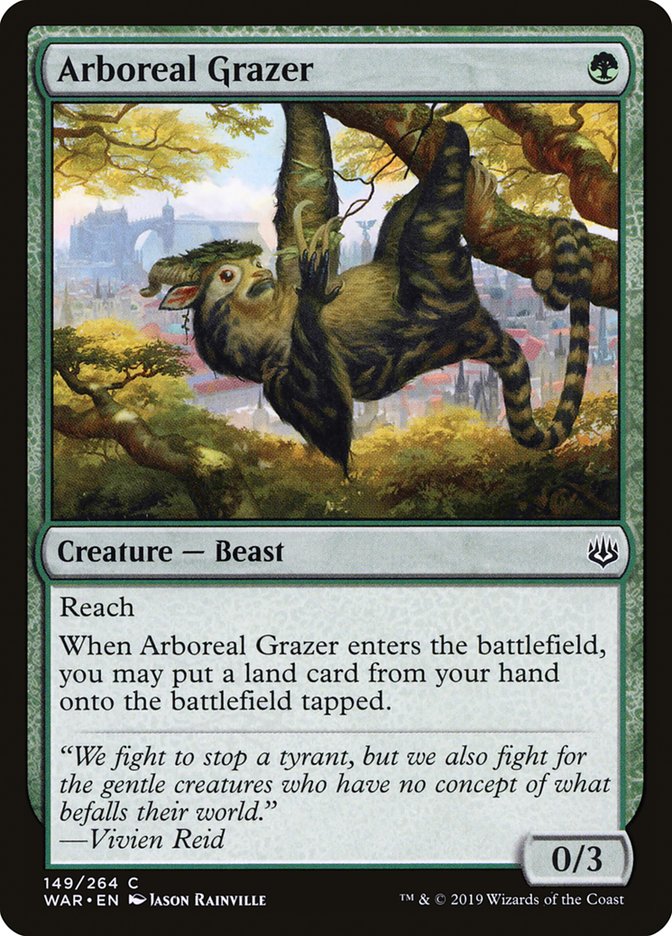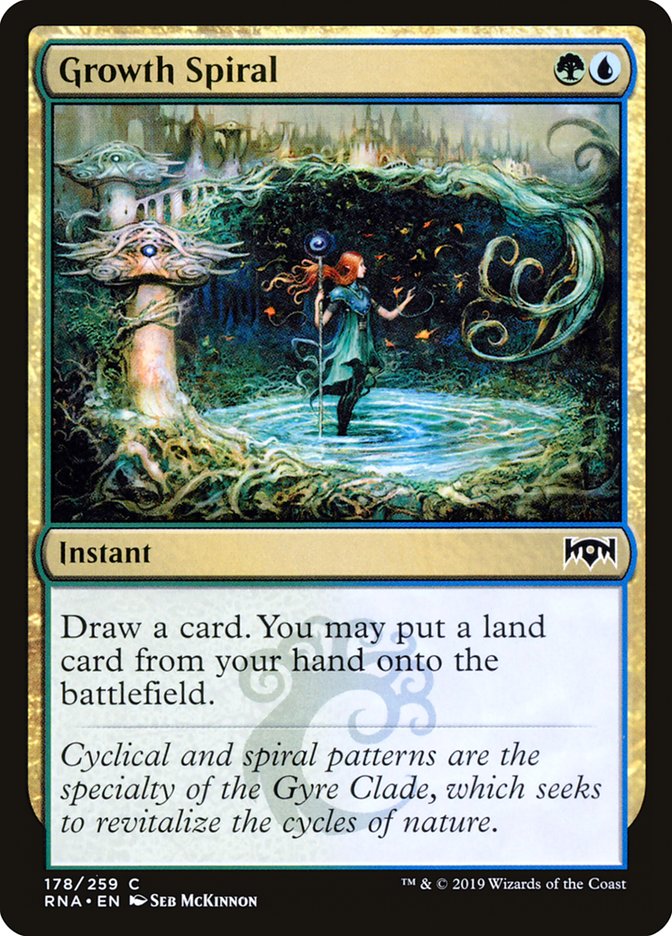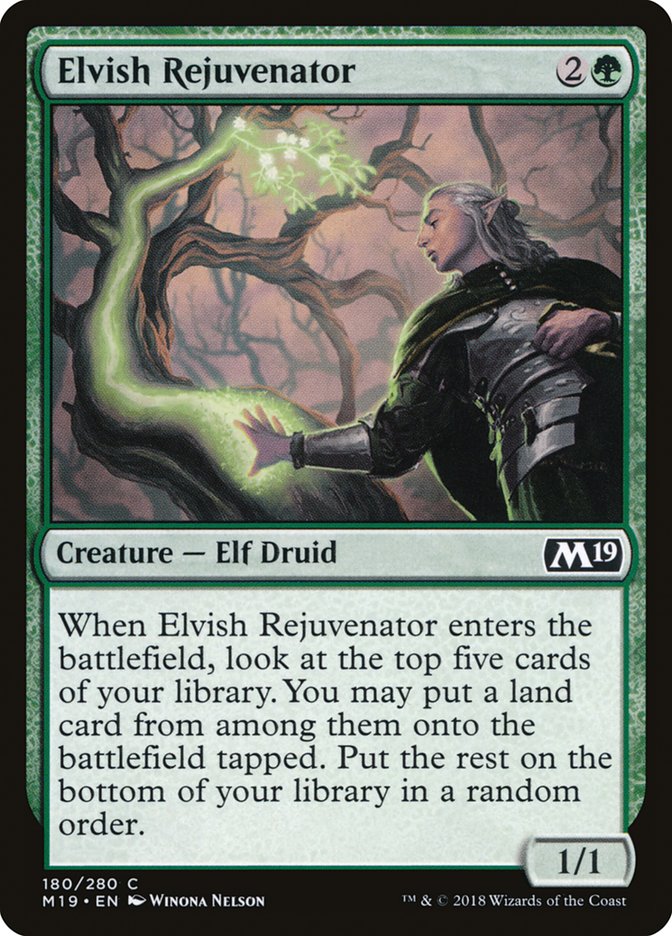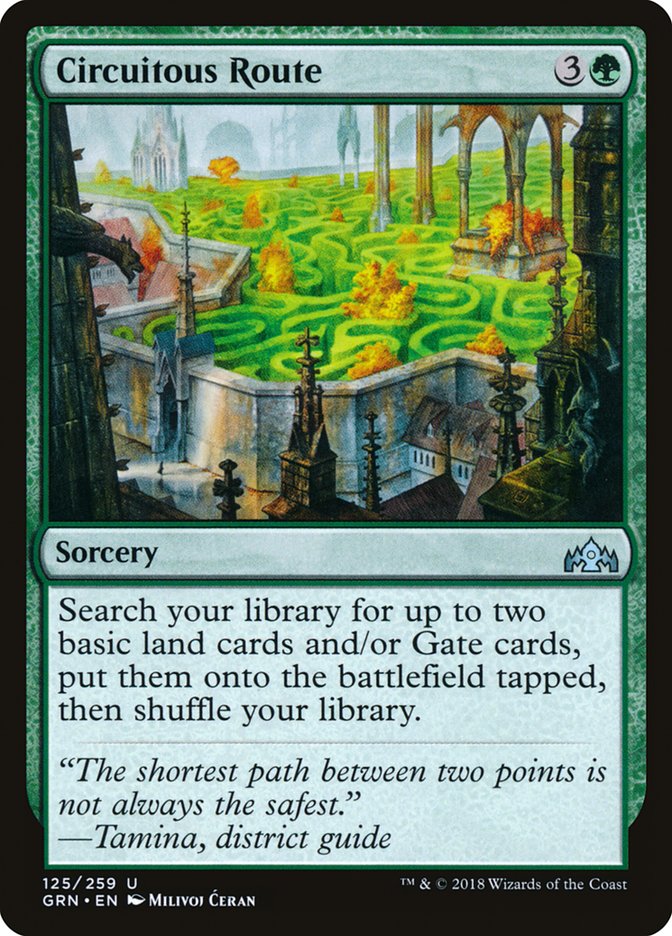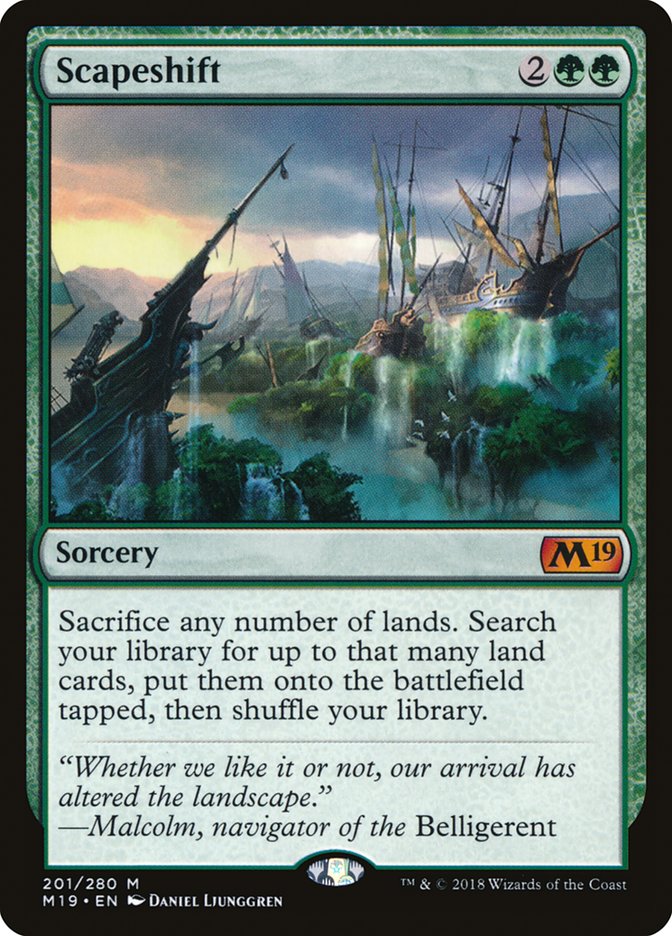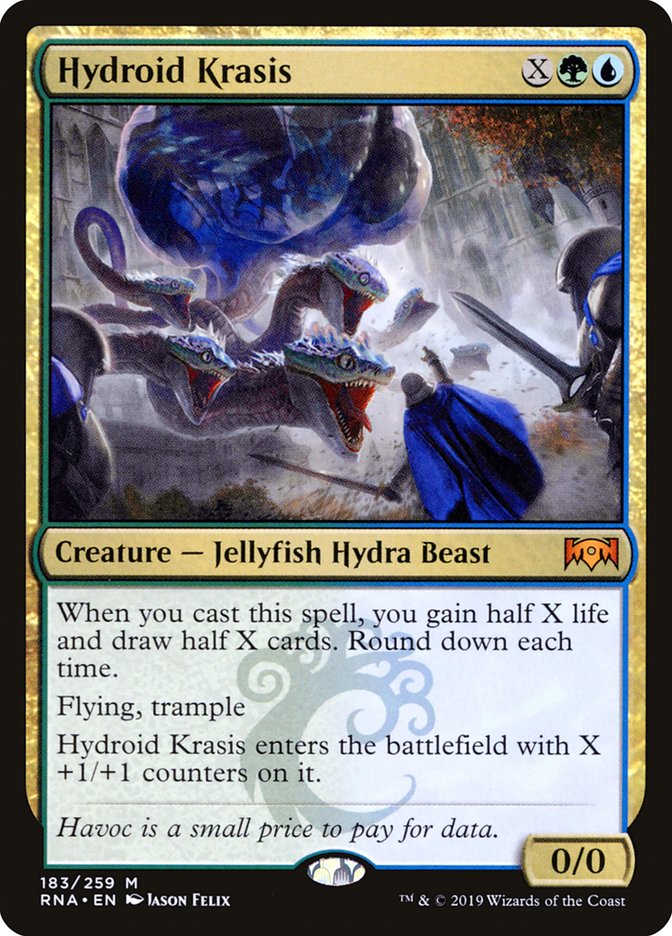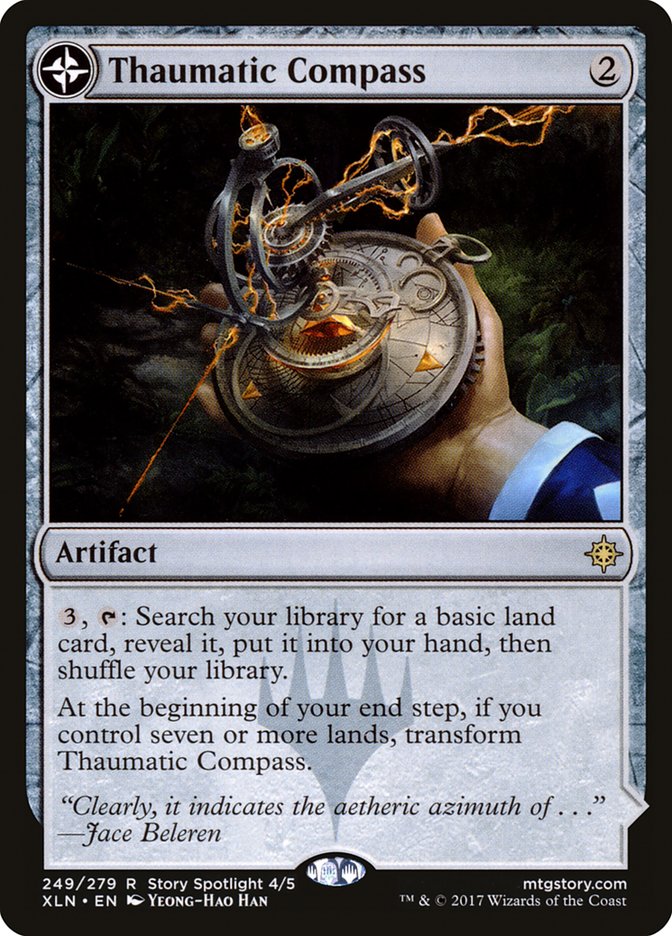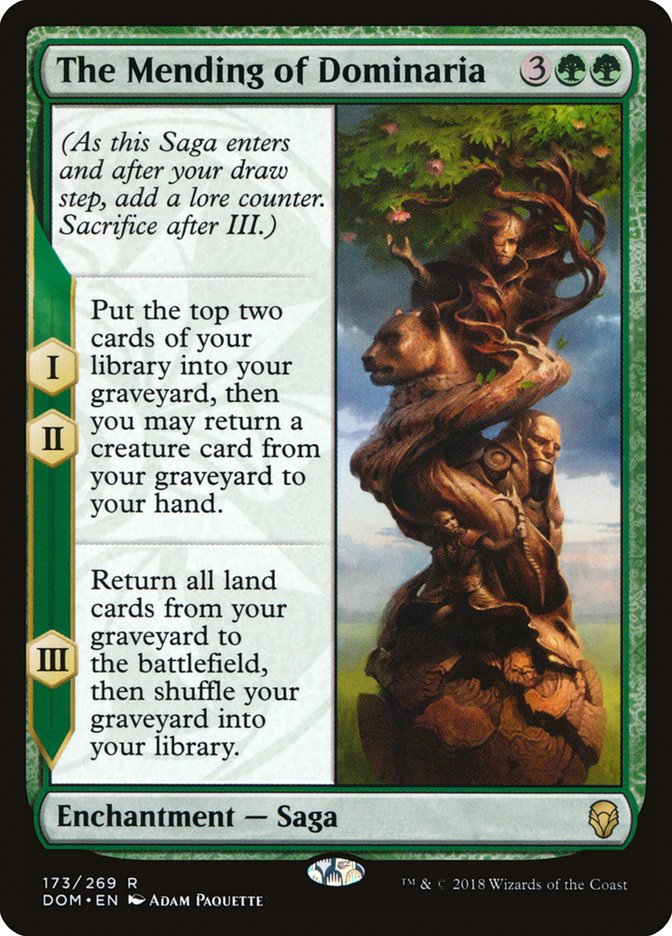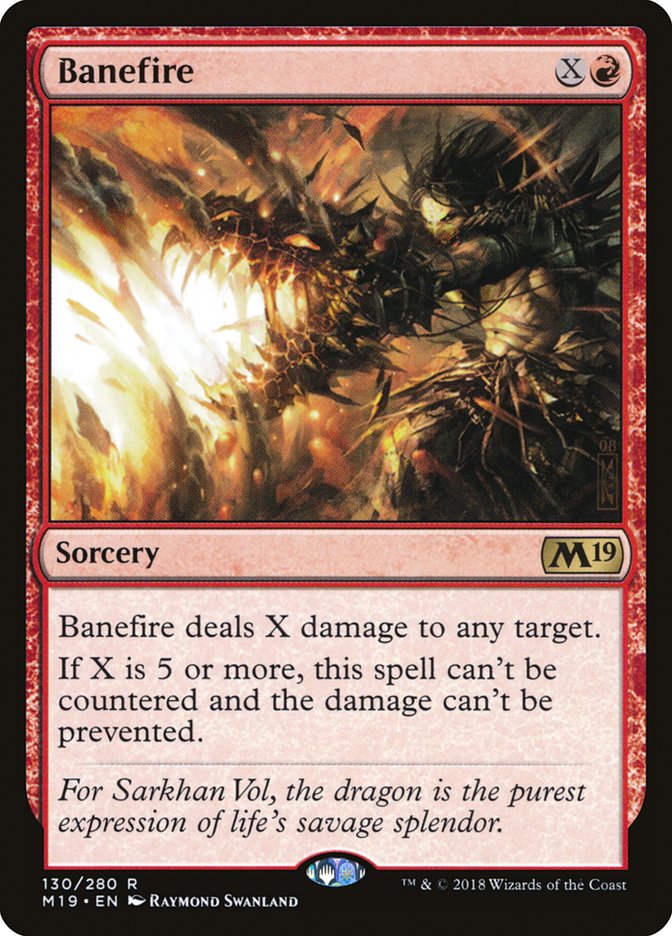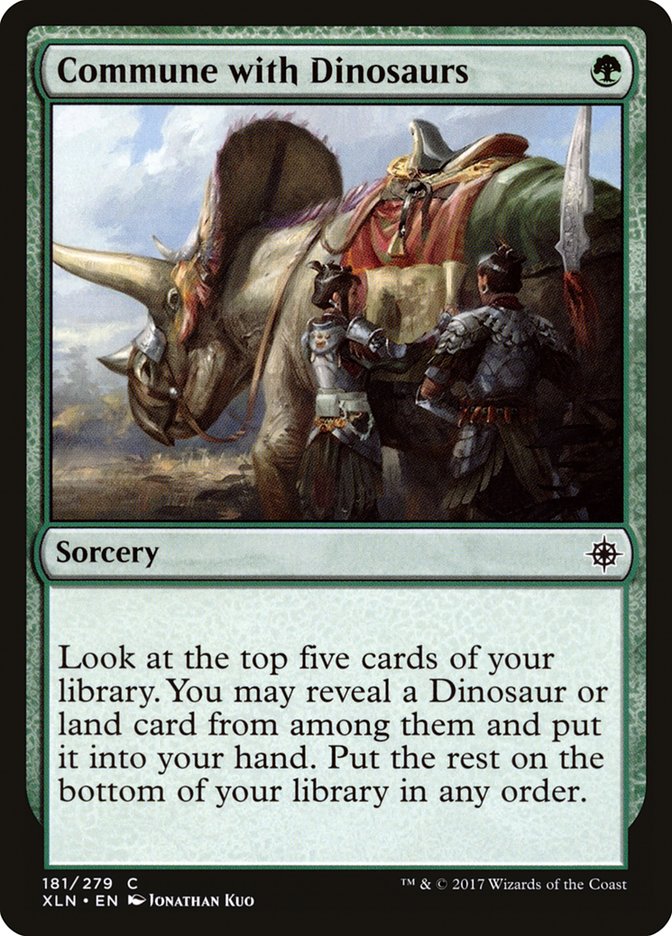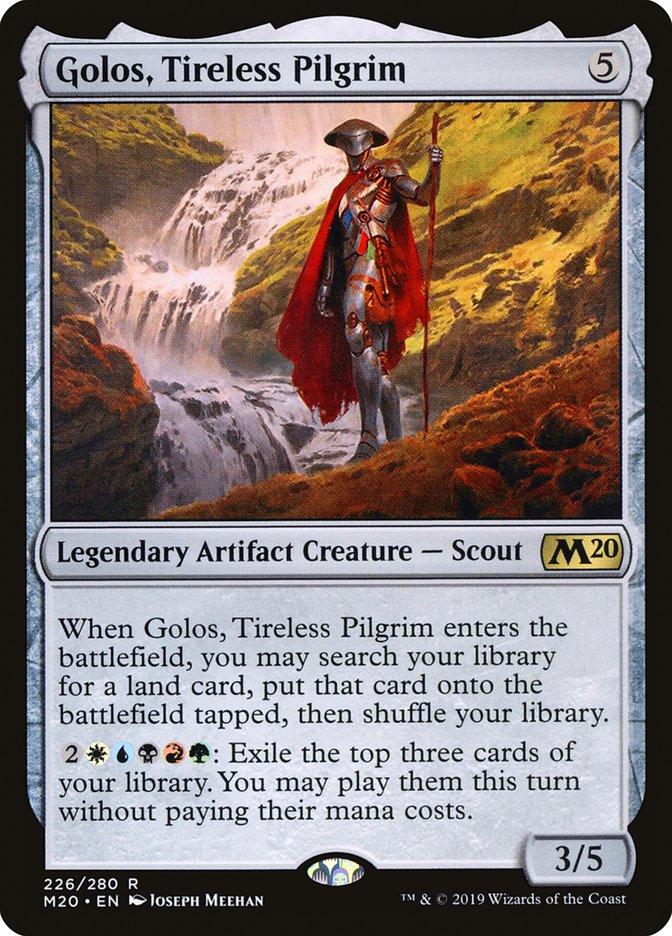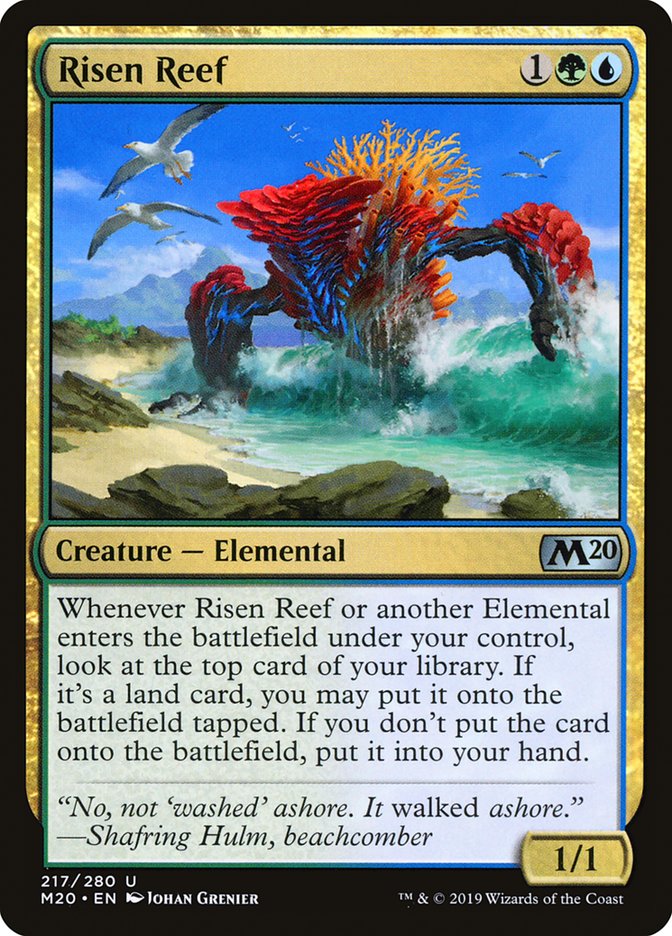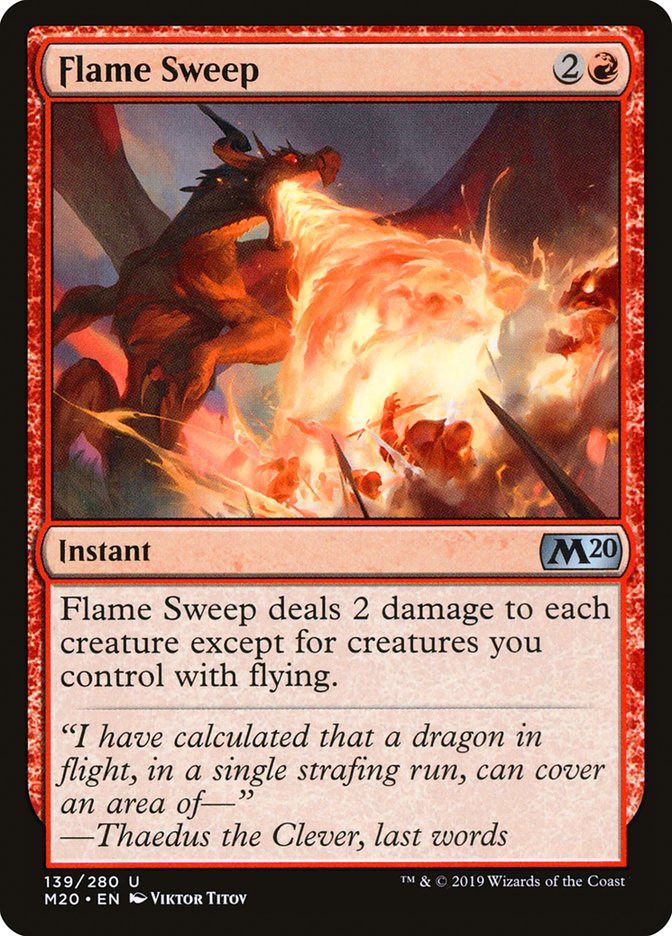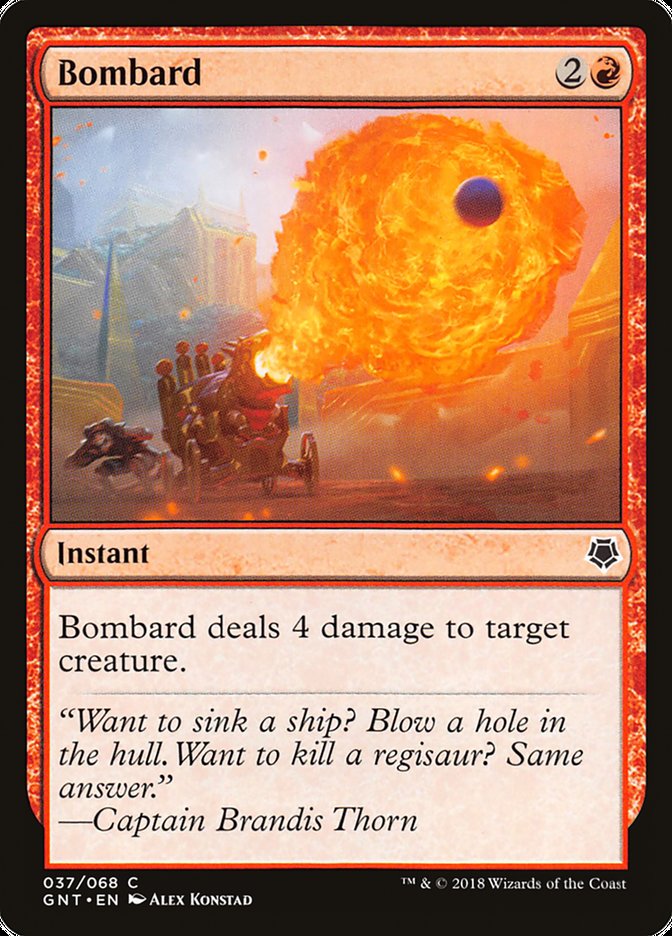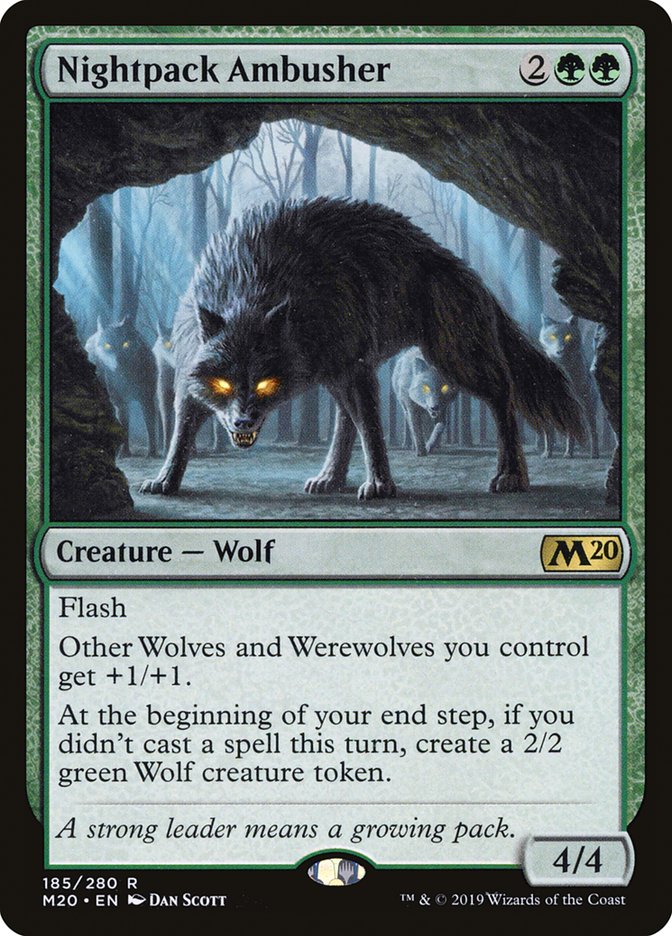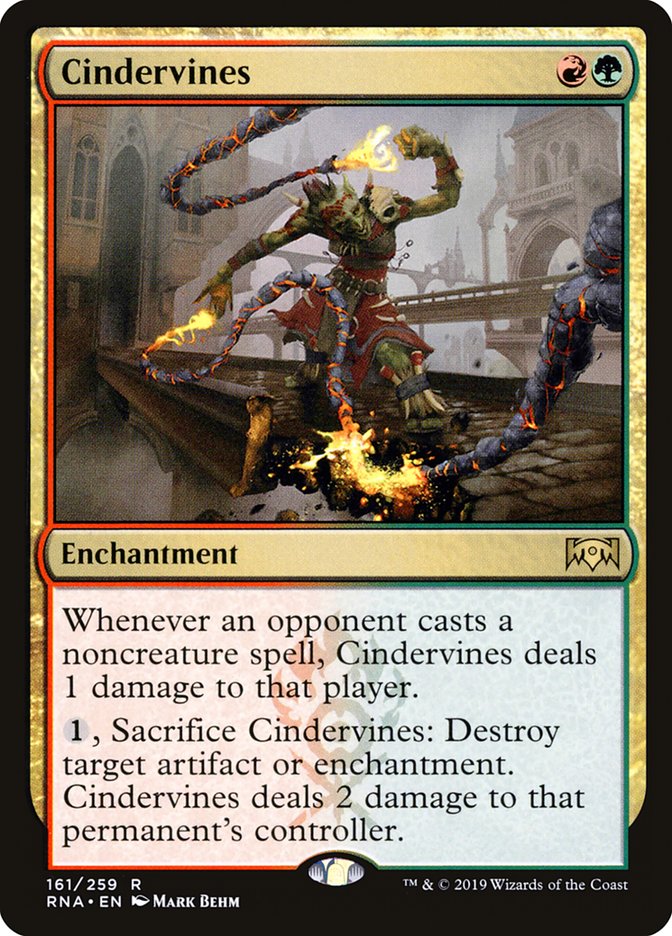Thanks for reading and good luck in your next tournament.
…
Oh, you probably want a decklist. All right, I’ll try to break it down further.
I started messing around with Scapeshift after reading about Bill Stark’s exploration of the archetype on Facebook. His take was a mono-green approach, which I was interested in because it’s so dedicated, and plays The Mending of Dominaria, a card I just love.
The core of the deck is really just Arboreal Grazer, Elvish Rejuvenator, Circuitous Route, Scapeshift, and a bunch of differently named lands, several of which tap for green mana. Bill’s manabase was clever – all the green versions of all the good land cycles in Standard. This does a good job of getting land name diversity while allowing you to splash expensive spells, but not cheap spells that you want to reliably cast early. However, I think we can do better because Growth Spiral is so strong in the archetype.
Creatures (12)
Lands (30)
Spells (18)
- 4 Scapeshift
- 1 Banefire
- 2 Thaumatic Compass
- 3 The Mending of Dominaria
- 4 Circuitous Route
- 4 Growth Spiral
Sideboard

So why is this deck so good?
First, consistency. With 30 lands, you can keep most hands and rarely miss a land drop, and because your lands make Zombies when you have too many, it’s hard to flood out.
Second, and relatedly, redundancy. There are twelve “cheap” ramp spells, eight four-mana spells that help make lots of Zombies, and four Hydroid Krasis, doing normal Hydroid Krasis things in a deck with a ton of mana.
Third, positioning. As usual, Standard involves a lot of midrange decks doing midrange things, and this deck goes over the top of even the top end of pre-Core Set 2020 Standard. Nissa and Mass Manipulation, or a horde of Elementals, or whatever just won’t matter when you make more than 30 Zombies, which this deck does regularly. The aggro decks can’t quite meaningfully get under you, and the control decks can’t really answer the natural development of Field of the Dead with Hydroid Krasis.
Scapeshift’s biggest weakness is Nexus of Fate, as Zombies do not in any way go over the top of infinite turns. Cindervines and Blast Zone give you some ability to try to keep Wilderness Reclamation off the battlefield, but the matchup is definitely not good. Outside of that, things look pretty solid.
With all that in mind, let’s go over the specific card choices.
Arboreal Grazer has disappointed me almost every time I’ve tried it, but 30 lands is actually enough lands to make the card work, especially since getting lands onto the battlefield really is the end-game. The body is a decent speed bump, but you’re very much here just to get your lands onto the battlefield faster, of course.
Growth Spiral does exactly that without costing a card. The mana to support it is slightly awkward, and I think it’s possible that the best build doesn’t play any cheap cards that aren’t green, but casting it is so good that I think it’s worth the risk.
Elvish Rejuvenator is outstanding here because it both ramps and digs for Field of the Dead, which is extremely important to find.
Circuitous Route is probably the backbone of the deck, since it ramps you up to trigger Field of the Dead, and once you’re already there, it’s still good for two more triggers from each of your Fields while powering up future Scapeshifts.
Scapeshift isn’t good early like Circuitous Route, but once you have eight-plus lands it basically requires a sweeper from your opponent, and even if they have one, it leaves you with a library dense with spells and usually multiple active copies of Field of the Dead on the battlefield.
Hydroid Krasis is beyond requiring explanation at this point. If your deck makes a lot of mana and can cast blue and green spells, the burden of proof is really on not playing it.
Thaumatic Compass, The Mending of Dominaria, and Banefire are the cards I’m less sure about. Thaumatic Compass helps make sure you don’t miss a land drop, but you’re unlikely to anyway. It gives you an extra land when it transforms, but you already have enough at that point anyway and transforming doesn’t trigger Field of the Dead. That said, I’ve been happy with it as a way to stop flyers that can otherwise ignore your Zombie horde.
The Mending of Dominaria is a nice way to guarantee inevitability. I’ve generally cast it the turn before I cast Scapeshift, and then if the opponent can answer the Zombies from the Scapeshift, The Mending of Dominaria gives you a much larger horde the next turn while guaranteeing that you don’t deck yourself. Realistically, this is mostly a concern in Scapeshift mirrors, so I’m not sure that it’s worth the slot.
The other primary use for The Mending of Dominaria is as a big spell if you don’t draw Scapeshift, where it can be expected to mill around two lands in its first two stages (while digging four cards for Field of the Dead) and also returns any Evolving Wilds, Blast Zones, or Field of Ruins you’ve used, so it acts as an extra Circuitous Route that maybe does a little more while potentially returning some creatures on the way, which, while slower, is a lot of extra value for only one more mana.
Banefire is another card I don’t know that you really need, but I’ve stolen games in the mirror with it and it’s nice to have access to a way to deal with a highly problematic creature or planeswalker.
Other considerations that aren’t in at the moment:
Weirdly, Commune with Dinosaurs might be reasonable to play even without Dinosaurs as a way to find blue mana or Field of the Dead. It also makes Shifting Ceratops a more desirable sideboard card if Mono-Blue Aggro is a concern, though I haven’t run into it. It’s even better if you’re also playing cards of another color.
This deck is very interested in the natural hate for Nexus that Teferi provides, as well as a way to make sure that your Scapeshift resolves. Better yet, it allows you to Scapeshift at the end of your opponent’s turn to get around most sweepers (or in combat to eat your opponent’s attackers, but realistically it doesn’t truly matter if your opponent’s creatures are on the battlefield or not when you resolve Scapeshift most of the time). Making the mana work with another color, especially for a three-drop, isn’t trivial, but it might be worth stretching it a bit and/or using Commune with Dinosaurs to help out.
Golos, Tireless Pilgrim is an alternative to The Mending of Dominaria. Where The Mending of Dominaria might be too win-more, Golos might, weirdly, be too low-impact. It’s obviously great to have more ways to search for Field of the Dead, but the deck is pretty good at finding it as-is, and with so many lands and Hydroid Krasis, the activated ability just doesn’t do that much if you don’t hit a Scapeshift.
@ObstinateBaloth tweeted about hitting #1 in Mythic on Arena with a Bant take on Scapeshift with Risen Reef and Teferi, Time Raveler, crediting @SyndromTTV as the creator playing four Risen Reef with no other Elementals, where it functions as a much worse Elvish Rejuvenator that gets better in multiples. I’m a little skeptical, but it’s about as good as one of your best cards about half the time and potentially much better if you draw two, so I could see it. For reference, here is their deck:
Creatures (16)
Planeswalkers (4)
Lands (23)
Spells (17)

Comparing these approaches, the biggest difference is really the sideboard, since the purpose of Temur Scapeshift is access to the red sideboard cards. Flame Sweep is pretty obviously good against wide aggro decks like Orzhov Vampires and can clear a Scapeshift opponent’s Zombies.
Bombard is really weird to see. Playing Bombard in a format where Lightning Strike and Lava Coil are both available is wild and would only happen if there was a very specific threat we were trying to answer, which is the case here, of course, and that threat is Nightpack Ambusher.
Nightpack Ambusher is the key card in a deck that can punish slow, sorcery-speed Scapeshift, and it needs to be answered by an instant so that it can be removed before its caster untaps with mana to counter your answer.
Cindervines is probably an upgrade to green answers to enchantments against Nexus, but not much of an upgrade, since getting red mana isn’t trivial.
Meanwhile, Bant gets Ajani’s Welcome to combo with Scapeshift to end the game against any opponent that cares about your life total, plus Dovin’s Veto, though Temur could play Negate, and, interestingly, the advantage of Dovin’s Veto over Negate has diminished considerably since Dovin’s Veto can effectively be “countered” by Veil of Summer. Really, I think there’s a good chance that Negate is better than Dovin’s Veto in the Bant version and I’m not convinced the deck wants either one.
For what it’s worth, Bill Stark is using Narset’s Reversal (over Veil of Summer) in the sideboard to combat Nexus of Fate, which I could see being effective, though I have some concerns about UU. It does also have good applications against other big spells like Scapeshift / Circuitous Route, Command the Dreadhorde, and Finale of Glory.
I’m not sure if the Temur or Bant version is better, and, of course, I’m not sure which cards are best among the cards that I noted I wasn’t sure about. What I’m more confident in is that the general strategy of playing Scapeshift with Field of the Dead and not Dread Presence with a lot of ways to put more lands on the battlefield is well-positioned and powerful in Standard at the moment, and, for what it’s worth, I think the Bant deck referenced here isn’t playing enough lands. I’m pretty sure I prefer 29-30 to 27-28.
If you’re looking to play some games that aren’t particularly close, I recommend exploring this strategy.


